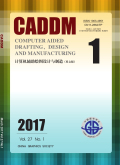- 钛学术文献服务平台 \
- 学术期刊 \
- 工业技术期刊 \
- 自动化技术与计算机技术期刊 \
- 计算机辅助绘图设计与制造(英文版)期刊 \
COMPARISONS OF THE H.264 AND H.263 VIDEO COMPRESSION STANDARDS
COMPARISONS OF THE H.264 AND H.263 VIDEO COMPRESSION STANDARDS
基本信息来源于合作网站,原文需代理用户跳转至来源网站获取
摘要:
The International Telecommunications Union (ITU-T) and the International Standardization Organization/International Electrotechnical Commission (ISO/IEC) are the only two formal organizations that developed video coding standards. The ITU-T video coding standards called recommendations and are usually optimized for real-time video communication such as videoconference and video telephony while the ISO/IEC standards are mainly designed for storage (DVD) and broadcast (satellite and digital TV). ITU-T and the ISO/IEC JTC1 have agreed to join their efforts in the development of H.264 standard, which was initiated by ITU-T committee. The ITU-T H.264 video coding standard has been developed to achieve significant improvements over the existing standards in compression performance, although the basic coding framework of the standard is similar to that of the existing standards. H.264 standard is compared with H.263 and test results showed the coding gains obtained by the H.264 encoder is over the H.263 encoder for Common Intermediate Format (CIF) and Quarter Common Intermediate Format (QCIF)sequences, respectively. H.264 achieves an average of 4 dB PSNR(peak signal-to-noise rate) gain for the selected ten CIF sequences at 30 frames per second, and 4.57 dB Peak Signal–to–Noise Rate (PSNR) gain for the selected ten QCIF sequences at 30 frames per second.

推荐文章
视频编码标准H.263码流结构的分析
视频编码
H.263
码流结构
PB帧
基于残差能量的H.263与H.264间的编码转换
编码转换
帧间预测
模式选择
离散余弦变换
H.263码流的RTP封装的研究与实现
实时传输协议
实时传输控制协议
H.263
封装
H.264标准在视频监控系统中的应用
H.264视频编码
帧内预测
帧间预测
熵编码
内容分析
关键词云
关键词热度
相关文献总数
(/次)
(/年)
文献信息
| 篇名 | COMPARISONS OF THE H.264 AND H.263 VIDEO COMPRESSION STANDARDS | ||
| 来源期刊 | 计算机辅助绘图.设计与制造(英文版) | 学科 | 工学 |
| 关键词 | |||
| 年,卷(期) | 2007,(1) | 所属期刊栏目 | |
| 研究方向 | 页码范围 | 86-94 | |
| 页数 | 9页 | 分类号 | TN919.81 |
| 字数 | 语种 | 中文 | |
| DOI | |||
五维指标
引文网络
引文网络
二级参考文献 (0)
共引文献 (0)
参考文献 (0)
节点文献
引证文献 (0)
同被引文献 (0)
二级引证文献 (0)
2007(0)
- 参考文献(0)
- 二级参考文献(0)
- 引证文献(0)
- 二级引证文献(0)
引文网络交叉学科
相关学者/机构
期刊影响力
计算机辅助绘图设计与制造(英文版)
主办单位:
中国图学学会
出版周期:
季刊
ISSN:
1003-4951
CN:
11-2862/TP
开本:
出版地:
北京海淀区学院路37号北航内 中国图学学会
邮发代号:
创刊时间:
语种:
eng
出版文献量(篇)
504
总下载数(次)
0
总被引数(次)
561
期刊文献
相关文献
推荐文献
- 期刊分类
- 期刊(年)
- 期刊(期)
- 期刊推荐
一般工业技术
交通运输
军事科技
冶金工业
动力工程
化学工业
原子能技术
大学学报
建筑科学
无线电电子学与电信技术
机械与仪表工业
水利工程
环境科学与安全科学
电工技术
石油与天然气工业
矿业工程
自动化技术与计算机技术
航空航天
轻工业与手工业
金属学与金属工艺
计算机辅助绘图设计与制造(英文版)2017
计算机辅助绘图设计与制造(英文版)2016
计算机辅助绘图设计与制造(英文版)2015
计算机辅助绘图设计与制造(英文版)2014
计算机辅助绘图设计与制造(英文版)2013
计算机辅助绘图设计与制造(英文版)2012
计算机辅助绘图设计与制造(英文版)2011
计算机辅助绘图设计与制造(英文版)2010
计算机辅助绘图设计与制造(英文版)2009
计算机辅助绘图设计与制造(英文版)2007
计算机辅助绘图设计与制造(英文版)2006
计算机辅助绘图设计与制造(英文版)2005
计算机辅助绘图设计与制造(英文版)2004
计算机辅助绘图设计与制造(英文版)2003
计算机辅助绘图设计与制造(英文版)2002
计算机辅助绘图设计与制造(英文版)2001

 免费查重
免费查重










